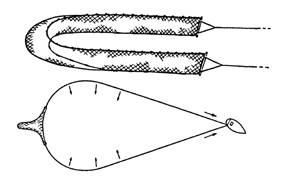Diagnosis: body elongated and rounded, head broad and only slightly flattened above, snout rounded, mouth inferior; osseous head shield coarsely rugose, fairly visible through the skin; occipital process prominently broad at base, tapering posteriorly, with a median keel; predorsal plate very rugose, short and crescent-shaped; premaxillary teeth villiform, forming a plate slightly curved; palatine teeth in two pairs of patches, an anterior subquadrate pair and a posterior elongated pair, the anterior one wider and continuous with the posterior patch; no gill-rakers on posterior face of the first and second branchial arches; total number of anterior gill-rakers: on 1st arch 17-22, on 2nd arch 18-23 (Ref. 3546, 7367, 57224). Dorsal and pectoral fins with a strong serrated, erectile spine; adipose fin well developed (Ref. 57224).
Description: cephalic shield exposed, very rugose and anteriorly extending to level of eye; fleshy furrow of median depression of head also extending anteriorly almost to eye level; maxillary barbels reaching to pectoral fin base, mandibular barbels shorter, 5-6x as long as broad; gill rakers moderately long; dorsal and pectoral fins rays preceded by strongly ossified spine with denticulate anterior border in former and denticulate posterior border in latter fins; caudal fin deeply forked with long and pointed lobes (Ref. 3546, 7367).
Coloration: dark brown on dorsum, lighter on sides and whitish ventrally (Ref. 57224, 81640). Some specimens have lighter brown dorsum; in these specimens fins are light brown with distal part of dorsal, pectoral, pelvic, anal and caudal fins darker to blackish; barbels of these specimens are also whitish; some other specimens have dark dorsum and dorsal, pectoral, pelvic, anal and caudal fins are entirely black except for the anal fin base and median part of anal fin; barbels of these specimens are also partially or entirely black (Ref. 81640).
 Image not available
Image not available





